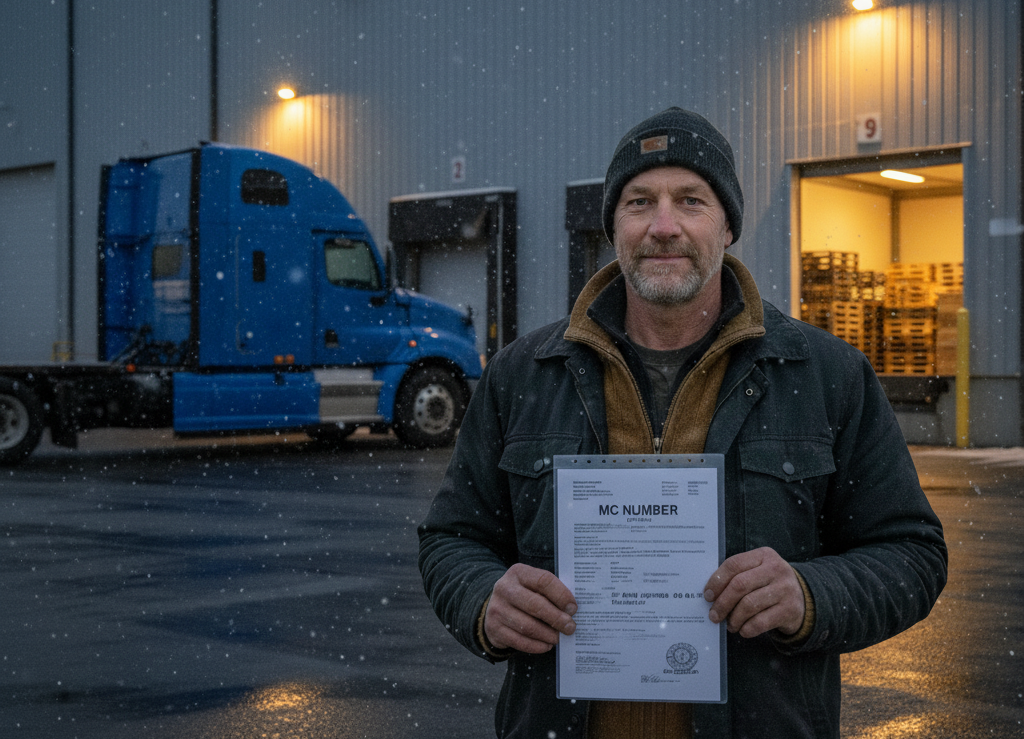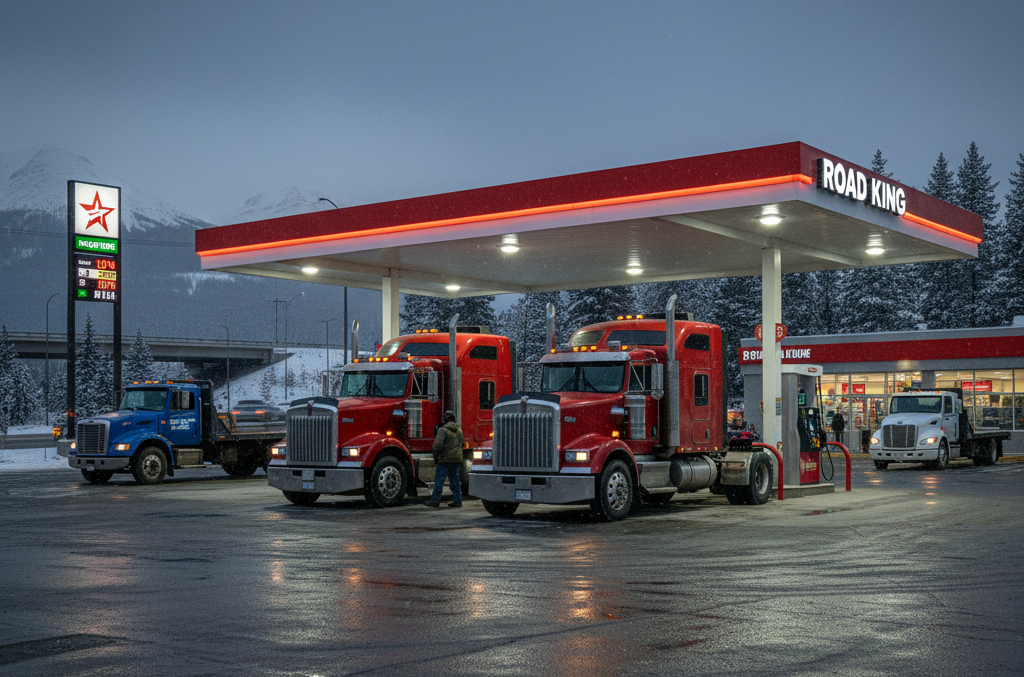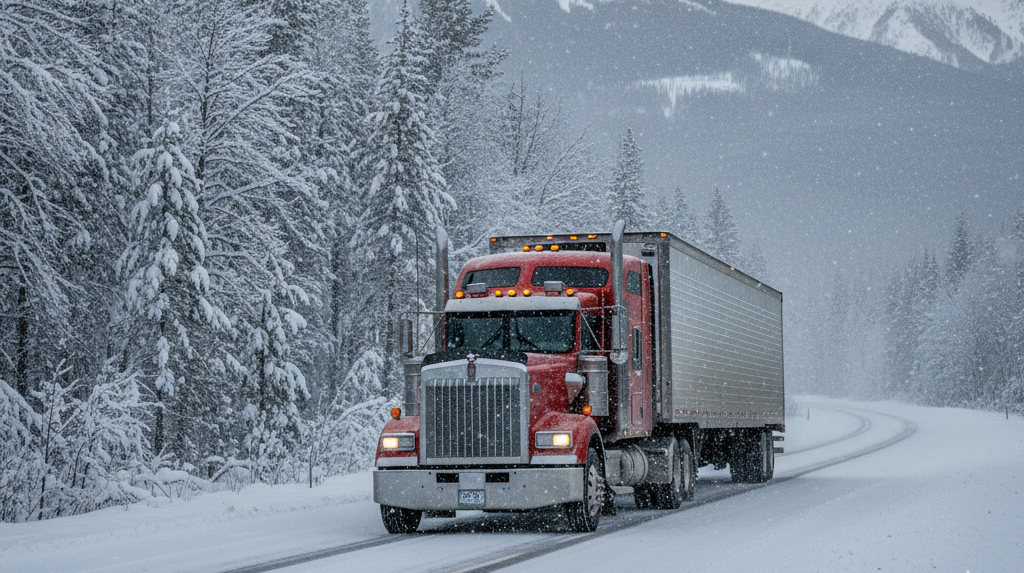What Does ‘Out for Delivery’ Mean?
In the trucking industry, ‘out for delivery’ signifies the last mile delivery. This status means the item was processed and sorted at a local distribution center and is now on its way to the delivery destination. In short, the load is no longer in a warehouse but in transit to the customer.
This term is associated with the last mile delivery process. Once a driver marks a package as out for delivery, they are working within a scheduled route to make deliveries within a particular area.
The out for delivery meaning is straightforward. The shipment is near completion and can be delivered by the end of the day. For many clients, seeing this notification is reassuring, as it indicates the waiting period for the package delivery is almost over. For businesses managing shipments, this means helping in planning or preparing for receiving goods, especially for companies that operate in industries that rely on just-in-time delivery practices.
However, it’s important to remember that delivery time can vary amid traffic, weather conditions, or the volume of deliveries. The time for delivery completion depends on the efficiency of the delivery service or trucking company.
Key Stages in the Delivery Process
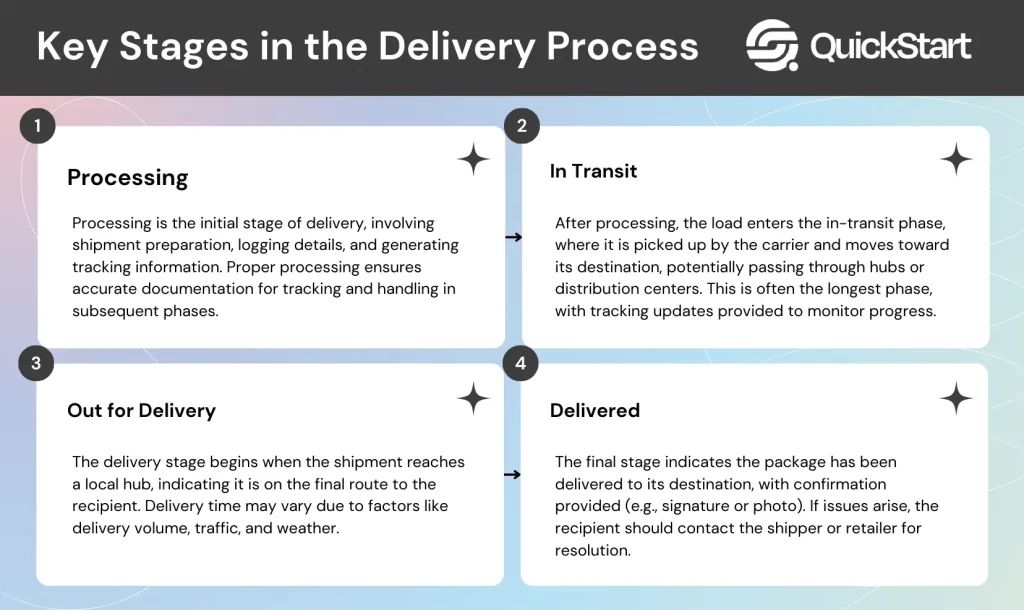
The delivery process involves several key stages. Efficient management and cooperation ensure a shipment is transported from the producer or sender to the client in a timely and organized manner. This ensures increased customer satisfaction. Each stage requires careful planning for maintaining the efficiency of the supply chain and the overall customer experience. Understanding these stages can help better track their shipments and manage the delivery process.
Processing
The first stage of the delivery is processing. It starts with the preparation of a shipment or an order placement. During this stage, the trucking company or logistics provider receives the shipment details, such as the item’s size, weight, destination, and any specific handling requirements. Then, the shipment is logged into the company’s system, labeled, and scanned to generate tracking information.
This stage is important because it establishes the foundation for the entire delivery process. Proper processing ensures that the package is correctly documented, allowing for tracking and handling through the next phases. Any errors or inaccuracies can delay delivery of the load.
In Transit
After the processing, the load moves into the in-transit phase. During this time, the shipment is picked up by the carrier and is traveling toward the delivery destination. The load may pass through various hubs, warehouses, or distribution centers, depending on the shipping route and the distance between the sender and the receiver.
Often, in transit is the longest delivery phase, especially for long-haul or international shipments. Throughout this stage, tracking updates are usually required to provide the shipper and the recipient to monitor the progress of the delivery. Sometimes, shipments can be held temporarily at a local distribution center before moving on to the final destination.
Out for Delivery
As the shipment reaches the nearest distribution hub or local warehouse to the final point, it enters the delivery stage. This signals that the package is on the final way to the recipient. During this delivery phase, the delivery truck follows a predetermined route, making stops to drop off the packages.
The out for delivery status often means the shipment will be delivered to the client by the end of the day. However, delivery time can vary amid factors such as the volume of deliveries, traffic conditions, and weather.
Delivered
This is the final stage in the shipping process. It indicates the package has reached the final destination. Once the driver hands over the package, a confirmation of delivery is provided. This can include a signature, a photo, or an electronic receipt, depending on the delivery service and its policies.
When the load is marked as delivered, the transportation process is complete. In case of any issues, such as missing items, damage during transit, or incorrect delivery, the recipient should contact the shipper or retailer for resolution.
Differences Between ‘Out for Delivery’ and Other Statuses
Understanding the statuses and phases of the delivery process is essential for tracking the shipment and managing the entire process. Each status provides valuable information about where the load is, from the moment it is processed for delivery to reaching the final destination. One of the most important updates is out for delivery, as it signifies that the shipment is on the final leg of the delivery. Thus, it’s important to know how out for delivery differs from other key statuses.
Processing is the first stage of the delivery process. It indicates the placement of an order and the shipment preparation for transit. During processing, the load is sorted, labeled, and scanned. Still, this stage doesn’t involve the start of the transportation.
As for out for delivery status. This signifies the package left the facility and is on its way to the recipient. In short, the out for delivery meaning signifies the package is almost delivered, while processing means the preparation of the load.
When the load is marked in transit, it means it is on the way to a local hub or distribution center. The status indicated the shipment has been picked up from the sender and is moving through the transportation network. In transit is a broad term and can include different modes of transport, especially for long routes or international deliveries.
The out of delivery status of more specific. The package has reached the local facility, has been loaded onto a delivery truck, and is being shipped to the recipient.
The delivered status is the final delivery stage. It means the load has arrived at the recipient’s address. Thus, the delivery is complete with a provided confirmation. Its main difference with the out for delivery status is that delivered means the end of the load journey, while out for delivery is the last step before the final confirmation.
How Long Does ‘Out for Delivery’ Take?
The out for delivery status often means the package will be delivered by the end of the day. However, the exact time depends on several factors. Understanding these variables can help manage expectations and provide a clearer picture of the arrival time of the shipment.
Time of day. The timing of the delivery notifications has a significant impact on when the package will arrive. If the status changes early in the day, the delivery can be completed within a few hours. At the same, if the update occurs in the afternoon or evening, the package might arrive closer to the end of the delivery window.
Delivery route. The route significantly impacts delivery time. If it is straightforward with minimal stops, the load may be received sooner. If the route involves driving through urban areas with heavy traffic or numerous drop-offs, it may take longer.
The volume of deliveries. The number of packages also affects delivery date. During busy periods, such as the holiday season, shipping service may experience higher volumes of shipments. This can slow down the overall delivery process and lead to delays.
Traffic and weather conditions. These external factors can cause unexpected delays. Heavy rain, snow, or road construction can impact the driver’s ability to maintain their schedule. The package can be delivered later as expected amid these obstacles, despite our delivery status.
Why Might ‘Out for Delivery’ Be Delayed?
Understanding issues that can delay the final delivery of the load can help manage expectations and plan accordingly. If significant delays occur, it’s important to check the tracking information for possible updates that include a reason for the delays and expected delivery time.
Traffic conditions
It’s one of the most common reasons for delays. If the delivery route involves navigating through busy streets or highways or the driver faces unexpected traffic jams, accidents, or road closures, it can slow down the shipping process. This is particularly true during rush hours when roads are more crowded.
Weather issues
Severe weather conditions can also impact delivery schedules. Heavy rain, snow, ice, or storms can make driving hazardous and slow down the delivery. In particular, snow and ice can make roads difficult to navigate, forcing drivers to reduce their speed or take alternate routes. In case of extreme weather, delivery companies may prioritize the safety of their drivers and vehicles, instructing them to delay the delivery or avoid certain routes.
High volume of deliveries
During peak seasons, shipping companies can experience an increased volume of shipments. This can overwhelm delivery drivers and logistics systems, causing delays.
Delivery vehicle issues
Mechanical problems with delivery trucks can also cause delays. If a delivery vehicle breaks down, it may result in a halt to the delivery process. The shipping company may need to reroute deliveries or send another truck to complete the route.
Package size and handling
Larger or heavier loads can require special handling, which can slow down the process. In addition, if the shipment is fragile or involves specific delivery instructions, this can add time to the delivery process.
Errors or miscommunication
Sometimes, delays may occur due to internal system errors or miscommunication within the shipper. In these cases, packages can be marked out for delivery prematurely or not being routed correctly. Such errors may include incorrect tracking information or mislabeling.
What to Do if Your Package Says ‘Out for Delivery’ but Doesn’t Arrive
If your package is marked as out for delivery but doesn’t arrive within the expected time, it’s necessary to investigate the issue. Remaining proactive and informed can help you resolve the situation effectively, ensuring your shipment will reach you in a timely manner. You can take the next steps to address the issue:
Check tracking updates. First, you should check the tracking information provided by the shipper. Sometimes, delays can be reflected in updated tracking status. Look for any new information or estimated delivery times.
Contact the delivery company. If the package doesn’t arrive by the end of the expected timeframe, reach out to the carrier’s customer service for assistance. They can provide more details on the package status and any potential delays. For that, you must have your tracking number to help them locate your load.
Check delivery notifications. Some companies include notifications in their courier service, such as photos or alerts via text or email. Review these notifications to confirm whether the package was delivered.
File a claim. If your package hasn’t arrived after following these steps and waiting, you may need to file a claim. It’s especially important if you suspect it might be lost. Most carriers have procedures for reporting lost or missing packages. Filing a claim also requires a tracking number of your shipment. You must also provide details about the contents and any relevant documentation.
What If Your Package Gets Stolen After ‘Out for Delivery’?
Experiencing a package theft is frustrating, especially if it was marked as out for delivery. If you face this situation, you can take certain steps to address it. With quick and efficient acting, you can help recover your lost items and protect yourself against future thefts.
Confirm delivery status. Double-check the tracking status to ensure the package was indeed marked as delivered. Review any notifications from the carrier that may provide details about the expected delivery date and location. Sometimes, the loads can be marked as delivered prematurely, and they may arrive shortly.
Check surrounding areas. Investigate your home or office and surrounding areas. Delivery employees may leave packages in less visible locations to protect them from theft. In addition, you can review security footage if you have a security camera. This can provide evidence regarding what happened to the package.
File a police report. If you’re sure your package was stolen, consider filing a police report. This can help you in dealing with the shipping company or your insurance provider. Police may require additional evidence, such as security footage or eyewitness accounts.
Notify the carrier. Contact the shipping carrier to report the theft. Sometimes, the shipping company has specific protocols for dealing with it and may provide assistance or guidance on how to process it. In addition, some carriers can offer protection plans or insurance that cover losses.
Check with the retailer. In case of shipment theft, reach out to the retailer’s customer service team. They may offer a replacement or refund. Provide them with relevant information, such as order details and tracking information.
Consider shipment insurance. To prevent future thefts, consider investing in package insurance for valuable items. In addition, you can consider different delivery options to ensure a safe process, such as requiring a signature upon receipt or using secure lockers or pickup locations.
Common Delivery Exceptions: What They Mean
Delivery exceptions can be confusing and impact customer satisfaction. Exceptions indicate that a shipment has faced an issue that prevents it from reaching the arrival on time. To effectively manage it, you should understand common exceptions and what they mean. It’s important to stay informed by checking the tracking status and communicating with the shipping carrier or retailer.
Address issues. This occurs when the final delivery address provided is incomplete, incorrect, or unclear. If the driver can’t locate the address or there are any discrepancies, the shipment may be returned to the sender or delayed until the resolution is reached.
Failed delivery attempt. If the delivery person attempts to deliver a package but no one is available to receive it, this can delay the delivery process. In this case, the delivery driver should leave a notification indicating that a delivery was attempted and provide instructions on how to reschedule or arrange for pickup.
Weather delays. If severe weather conditions make driving unsafe or reduce access to certain areas, the shipper may mark the package with a weather-related exception. Packages will be delivered once conditions improve.
Customs clearance delays. Customs inspections can lead to delays for international shipments as well. If a package is held up for inspection or requires additional documentation, the shipping status may reflect a customs exception.
Package damaged. If a shipment was damaged during transit, the carrier may mark it with a damage exception. The carrier may return the package to the sender or repackage it for further delivery, depending on the damage.
Carrier issues. Sometimes, the carrier may experience operational challenges, including staffing shortages or delivery vehicle breakdowns. It can cause delays in processing and delivering loads.
Holidays and peak seasons. During busy periods, such as holidays, delivery service may face higher volumes of packages. The increased demand usually results in exceptions due to overload or backlog in the system.
How to Speed Up Delivery (Expedited Options)
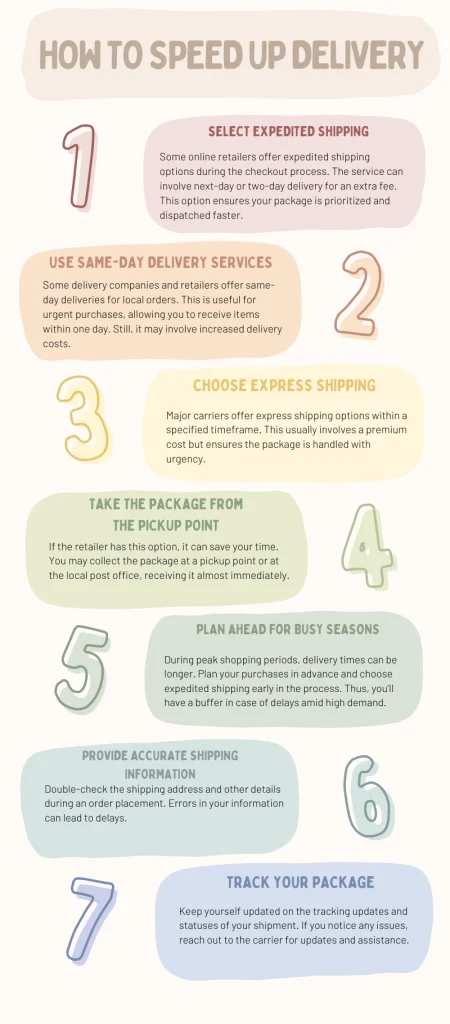
If you need your shipment to be delivered quickly, there are several expedited delivery options to get your shipment faster. This includes selecting faster shipping methods, cooperating with local services, and being proactive in managing your orders. Here’s a look at several strategies that can help you get what you need without delays:
Select expedited shipping. Some online retailers offer expedited shipping options during the checkout process. The service can involve next-day or two-day delivery for an extra fee. This option ensures your package is prioritized and dispatched faster.
Use same-day delivery services. Some delivery companies and retailers offer same-day deliveries for local orders. This is useful for urgent purchases, allowing you to receive items within one day. Still, it may involve increased delivery costs.
Choose express shipping. Major carriers offer express shipping options within a specified timeframe. This usually involves a premium cost but ensures the package is handled with urgency.
Take the package from the pickup point. If the retailer has this option, it can save your time. You may collect the package at a pickup point or at the local post office, receiving it almost immediately.
Plan ahead for busy seasons. During peak shopping periods, delivery times can be longer. Plan your purchases in advance and choose expedited shipping early in the process. Thus, you’ll have a buffer in case of delays amid high demand.
Provide accurate shipping information. Double-check the shipping address and other details during an order placement. Errors in your information can lead to delays.
Track your package. Keep yourself updated on the tracking updates and statuses of your shipment. If you notice any issues, reach out to the carrier for updates and assistance.
Conclusion
The out for delivery status represents the near completion of a load’s journey. However, various factors, such as traffic, weather, mechanical issues, or delivery volumes, can impact the scheduled delivery date. By understanding what does out for delivery mean, the stages of the delivery process, their meaning, and common causes for delays, businesses can manage customer expectations and plan accordingly. Whether it’s tracking package status, contacting carriers, or opting for expedited shipping options, proactive measures can help ensure successful delivery on time and keep the supply chain smooth.


